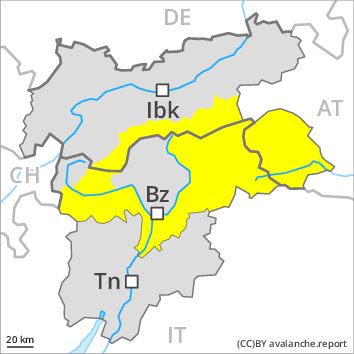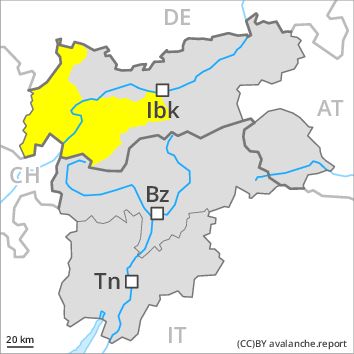Regions
Sexten Dolomites, Eastern Pfunderer Mountains, Durreck Range, Western Rieserferner Mountains, Gurgler Range, Western Deferegger Alps, Central Stubai Alps, Ortler Range, Schnals Ridge, Northern Zillertal Alps, Ulten Valley, Venediger Range, Southern Zillertal Alps and High Tauern, Eastern Nonsberger Alps, Eastern Rieserferner Mountains, Northern Dolomites of Fiemme, Saldurn-Mastaun Ridge, Glockner Range, Gröden Dolomites, Eastern Deferegger Alps, Prags Dolomites, Schober Mountains, Western Pfunderer Mountains, Lienzer Dolomites

Danger level
Danger Level 2 - Moderate
Avalanche Problem
Gliding snow above 2600m, E-SE-S-SW-W
Wind-drifted snow above 2400m, N-NE-NW

Gliding snow requires caution. Wind slabs at high altitude.
As the moisture increases small to medium-sized gliding avalanches and moist snow slides are possible. This applies in particular on steep sunny slopes below approximately 2600 m as well as on shady slopes at low and intermediate altitudes, especially in the regions with a lot of snow. Caution is to be exercised in areas with glide cracks.
In addition the fresh and older wind slabs should be taken into account. These can be released, especially by large additional loads, especially on northwest to north to northeast facing aspects above approximately 2400 m. The avalanches are rather small. The avalanche prone locations are clearly recognisable to the trained eye.
Weak layers in the old snowpack can still be released in isolated cases in particular in areas where the snow cover is rather shallow. This applies in particular on very steep sunny slopes above approximately 2500 m. Avalanches can be released, mostly by large loads and reach medium size. These avalanche prone locations are rare and are barely recognisable, even to the trained eye.
Snowpack
dp 2: gliding snow
dp 6: cold, loose snow and wind
The fresh and older wind slabs are lying on soft layers in particular on shady slopes at high altitude. Faceted weak layers exist in the top section of the snowpack on steep sunny slopes, in particular above approximately 2500 m. The snowpack will be subject to considerable local variations at high altitudes and in high Alpine regions. At low and intermediate altitudes the snow is moist, also on sunny slopes below approximately 2600 m.
Tendency
Slight increase in avalanche danger as a consequence of the precipitation.
Regions
Western Tuxer Alps, Karwendel Mountains, Eastern Tuxer Alps, Grieskogel Mountains, Eastern Lechtal Alps - Ammergau Alps, Mieming Mountains

Danger level
Danger Level 2 - Moderate
Avalanche Problem
Gliding snow above 2600m, E-SE-S-SW-W
Wind-drifted snow above 2400m, N-NE-NW

Gliding snow requires caution. Wind slabs at high altitude.
As the moisture increases small to medium-sized gliding avalanches and moist snow slides are possible. This applies in particular on steep sunny slopes below approximately 2600 m as well as on shady slopes at low and intermediate altitudes, especially in the regions with a lot of snow. Caution is to be exercised in areas with glide cracks.
In addition the fresh and older wind slabs should be taken into account. These can be released, especially by large additional loads, especially on northwest to north to northeast facing aspects above approximately 2400 m. The avalanches are rather small. The avalanche prone locations are clearly recognisable to the trained eye.
Snowpack
dp 2: gliding snow
dp 6: cold, loose snow and wind
The fresh and older wind slabs are lying on soft layers in particular on shady slopes at high altitude. The snowpack will be subject to considerable local variations at high altitude. At low and intermediate altitudes the snow is moist, also on sunny slopes below approximately 2600 m.
Tendency
The avalanche danger will persist.
Regions
Western Lechtal Alps, Central Lechtal Alps, Glockturm Range, Weißkugel Range, Western Verwall Mountains, Eastern Verwall Mountains, Allgäu Alps, Silvretta, Samnaun Mountains, Northern Oetz and Stubai Alps

Danger level
Danger Level 2 - Moderate
Avalanche Problem
Gliding snow above 2600m, E-SE-S-SW-W
Wind-drifted snow above 2400m, N-NE-NW

Gliding snow requires caution. Wind slabs at high altitude.
As the moisture increases small to medium-sized gliding avalanches and moist snow slides are possible. This applies in particular on steep sunny slopes below approximately 2600 m as well as on shady slopes at low and intermediate altitudes, especially in the regions with a lot of snow. Caution is to be exercised in areas with glide cracks.
In addition the fresh and older wind slabs should be taken into account. These can be released, especially by large additional loads, especially on northwest to north to northeast facing aspects above approximately 2400 m. The avalanches are rather small. The avalanche prone locations are clearly recognisable to the trained eye.
Weak layers in the old snowpack can still be released in isolated cases in particular in areas where the snow cover is rather shallow. This applies in particular on very steep sunny slopes above approximately 2500 m. Avalanches can be released, mostly by large loads and reach medium size. These avalanche prone locations are rare and are barely recognisable, even to the trained eye.
Snowpack
dp 2: gliding snow
dp 6: cold, loose snow and wind
The fresh and older wind slabs are lying on soft layers in particular on shady slopes at high altitudes and in high Alpine regions. Faceted weak layers exist in the top section of the snowpack on steep sunny slopes, in particular above approximately 2500 m. The snowpack will be subject to considerable local variations at high altitudes and in high Alpine regions. At low and intermediate altitudes the snow is moist, also on sunny slopes below approximately 2600 m.
Tendency
The avalanche danger will persist.
Regions
Brandenberg Alps, Western Kitzbühel Alps, Wilder Kaiser Mountains - Waidring Alps, Eastern Kitzbühel Alps

Danger level
Danger Level 1 - Low
Avalanche Problem
Wind-drifted snow above 2400m, N-NE-NW

Wind slabs require caution.
The fresh and somewhat older wind slabs represent the main danger. The avalanche prone locations are to be found in particular on very steep shady slopes above approximately 2400 m. Caution is to be exercised in particular adjacent to ridgelines. Such avalanche prone locations are rare and are clearly recognisable to the trained eye.
Snowpack
dp 6: cold, loose snow and wind
The fresh and older wind slabs are lying on soft layers on shady slopes at high altitude. These have bonded quite well with the old snowpack. The snowpack will be moist at low and intermediate altitudes. This also applies on steep sunny slopes at high altitude. Thus far only a little snow is lying.
Tendency
The avalanche danger will persist.




